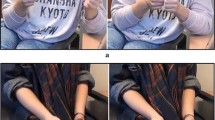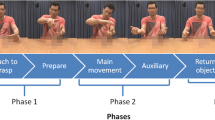Abstract
Humans gesture even when their gestures can serve no communicative function (e.g., when the listener cannot see them). This study explores the intrapersonal function of gestures, and the semantic content of the speech they accompany. Sixty-eight adults participated in pairs, communicating on an object description task. Visibility of partner was manipulated; participants completed half the task behind a screen. Participants produced iconic gestures significantly more for praxic items (i.e., items with physically manipulable properties) than non-praxic items, regardless of visibility of partner. These findings support the semantic specificity hypothesis, whereby a gesture is integrally associated with the semantic properties of the word it accompanies. Where those semantic properties include a high motor component the likelihood of a gesture being produced is increased, irrespective of communication demands.

Similar content being viewed by others
References
Alibali, M. W., Heath, D. C., & Myers, H. J. (2001). Effects of visibility between speaker and listener on gesture production: Some gestures are meant to be seen. Journal of Memory and Language, 44, 169–188.
Bates, E., & Dick, F. (2002). Language, gesture and the developing brain. Developing Psychobiology, 40, 293–310.
Beattie, G., & Shovelton, H. (1999). Do iconic gestures really contribute anything to the semantic information conveyed by speech? Semiotica, 123, 1–30.
Beattie, G., & Shovelton, H. (2002). What properties of talk are associated with the production of spontaneous iconic hand gestures? British Journal of Social Psychology, 41, 403–417.
Chawla, P., & Krauss, R. M. (1994). Gesture and speech in spontaneous and rehearsed narratives. Journal of Experimental Social Psychology, 30, 580–601.
Feyereisen, P., & Havard, I. (1999). Mental imagery and production of hand gestures while speaking in younger and older adults. Journal of Nonverbal Behaviour, 23, 153–171.
Freedman, N. (1977). Hands, words, and mind: On the structuralization of body movements during discourse and the capacity for verbal representation. In N. Freedman & S. Grand (Eds.), Communicative structures and psychic structures: A psychoanalytic interpretation of communication (pp. 109–132). New York: Plenum.
Freedman, N., van Meel, J., Barroso, F., & Bucci, W. (1986). On the development of communicative competence. Semiotica, 62, 77–105.
Frick-Horbury, D., & Guttentag, R. E. (1998). The effects of restricting hand gesture production on lexical retrieval and free recall. American Journal of Psychology, 111, 43–62.
Gentilucci, M., & Dalla Volta, R. (2008). Spoken language and arm gestures are controlled by the same motor control system. The Quarterly Journal of Experimental Psychology, 61, 944–957.
Goldin-Meadow, S. (2003). Hearing gesture: How our hands help us think. Cambridge, MA: Harvard University Press.
Iverson, J. M., & Goldin-Meadow, S. (1997). What’s communication got to do with it? Gesture in children blind from birth. Developmental Psychology, 33, 453–467.
Jacobs, N., & Garnham, A. (2007). The role of conversational hand gestures in a narrative task. Journal of Memory and Language, 56(2), 291–303.
Kendon, A. (1980). Gesticulation and speech: Two aspects of the process of utterance. In M. R. Key (Ed.), Relationship of verbal and nonverbal communication (pp. 207–228). The Hague: Mouton.
Kita, S. (2000). How representational gestures help speaking. In D. McNeill (Ed.), Language and gesture (pp. 162–185). Cambridge, UK: Cambridge University Press.
Krauss, R. M. (1998). Why do we gesture when we speak? Current Directions in Psychological Science, 7, 54–59.
Krauss, R. M., Dushay, R. A., Chen, Y., & Rauscher, F. (1995). The communicative value of conversational hand gestures. Journal of Experimental Social Psychology, 31, 533–552.
McNeill, D. (1985). So you think gestures are nonverbal? Psychological Review, 92, 350–371.
Morsella, E., & Krauss, R. M. (2004). The role of gestures in spatial working memory and speech. The American Journal of Psychology, 34, 411–424.
Morsella, E., & Krauss, R. M. (2005). Muscular activity in the arm during lexical retrieval: Implications for gesture-speech theories. Journal of Psycholinguistic Research, 34, 415–427.
Ozyurek, A., & Kita, S. (1999). Expressing manner and path in English and Turkish: Differences in speech, gesture and conceptualisations. In M. Hahn & S. C. Stoness (Eds.), Proceedings of the 21st annual meeting of the cognitive science society (pp. 507–512). Mahwah, NJ: Erlbaum.
Petitto, L. A., Holowka, S., Sergio, L. E., & Ostry, D. (2001). Language rhythms in baby hand movements. Nature, 413, 35–36.
Pine, K. J., Bird, H., & Kirk, E. (2007). The effects of prohibiting gesture on children’s lexical retrieval ability. Developmental Science, 10, 747–754.
Rausher, F., Krauss, R. M., & Chen, Y. (1996). Gesture, speech and lexical access: The role of lexical movements in speech production. Psychological Science, 7, 226–231.
Rose, M., & Douglas, J. (2001). The differential facilitatory effects of gesture and visualisation processes on object naming in aphasia. Aphasiology, 15, 977–990.
Weisberg, J., van Tourennout, M., & Martin, A. (2007). A neural system for learning about object function. Cerebral Cortex, 17, 513–521.
Wesp, R., Hesse, J., & Keutmann, D. (2001). Gestures maintain spatial imagery. American Journal of Psychology, 114, 591–600.
Willems, R. M., & Hagoot, P. (2007). Neural evidence for the interplay between language, gesture and action: A review. Brain and Language, 101, 278–289.
Author information
Authors and Affiliations
Corresponding author
Rights and permissions
About this article
Cite this article
Pine, K.J., Gurney, D.J. & Fletcher, B. The Semantic Specificity Hypothesis: When Gestures Do Not Depend Upon the Presence of a Listener. J Nonverbal Behav 34, 169–178 (2010). https://doi.org/10.1007/s10919-010-0089-7
Published:
Issue Date:
DOI: https://doi.org/10.1007/s10919-010-0089-7




